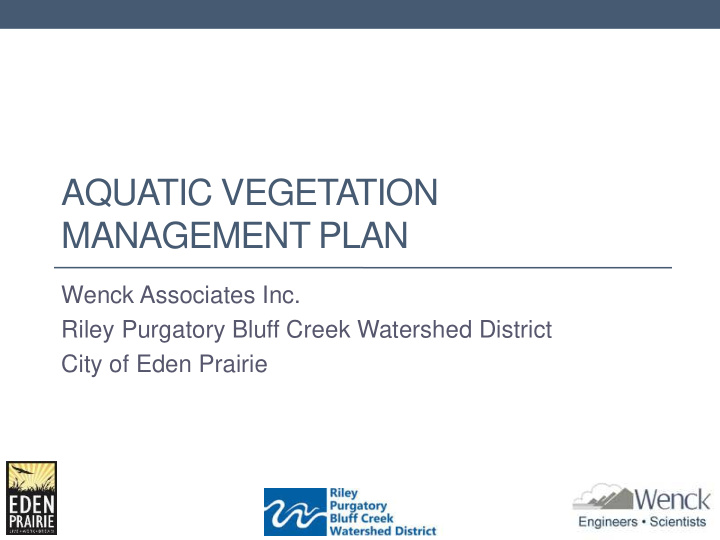



AQUATIC VEGETATION MANAGEMENT PLAN Wenck Associates Inc. Riley Purgatory Bluff Creek Watershed District City of Eden Prairie
Project Objective Develop an aquatic plant control program that defines the problems, identifies quantifiable management goals, and identifies specific management actions to improve lake conditions
Lake Issues • Submerged aquatic vegetation is over-abundant in the lake. The overabundance of submerged aquatic vegetation limits lake uses such as: • swimming in areas adjacent to property and in larger areas of the lake including the public landing • navigational access to most areas of the lake • fishing opportunities throughout the lake due to the thickness of the vegetation • aesthetics of the lake including water quality and SAV matting • Species diversity is limited in the three lakes.
Aquatic Plant Management Premise Diverse, native Monotypic SAV moderately Native, monotypic No Dominated by abundant plant SAV community Vegetation Invasive species community
DNR Regulations • DNR does not allow aquatic plant control for aesthetic purposes • Allowed for recreational access, invasive control • Mechanical control • May not exceed more than 50% of the littoral area of the lake • Can create open water areas for recreational use • Needs to be same location from year to year • Herbicide use is limited to 15% of the littoral area • Accounts for drift of the herbicide • Management of natives for recreational access requires a plant management plan • Mitchell Lake is a Natural Environment Lake which prevents the use of herbicides without a variance
Eurasian Watermilfoil Invasive Species
Recreational Management
Management Options Herbicides Harvesting
Current and Historical SAV Community
Invasive Species Management Options Red Rock Lake • Control Curly-leaf pondweed • Eurasian Water milfoil present in very low density • No management required at this time
Invasive Species Management Options Mitchell Lake • Mix of herbicide and mechanical harvest • Herbicide requires a variance in Natural Environment lakes • Herbicides more effective for long term suppression • Additional mechanical control
Recreation Management – Navigation/Swimming • Maintain navigable channels to open water • Create additional open water American Lotus area in south bay • Harvesting 2-3x per year • Supports swimming areas, fishing areas, edge habitat • Homeowners responsible for channel maintenance from dock to open water • Homeowners responsible for individual swimming/fishing area • Can hire harvesting company to maintain area (2,500 sq-ft)
Recreation Management – Navigation/Swimming • Maintain navigable channels to open water • Create additional open water area in middle bay • Harvesting 2-3x per year • Supports swimming areas, fishing areas, edge habitat • Homeowners responsible for channel maintenance from dock to open water • Homeowners responsible for individual swimming/fishing area • Can hire harvesting company to maintain area (2,500 sq-ft)
Plant Management Costs 15 Year Life Average Annual Cycle Cost 1 Cost 1 Alternative Description Acres Cost/Acre/Year Mitchell Lake Invasive Contract 1 23 $265,000 $17,667 $771 Harvesting 2 Invasive Contract Herbicide 13 $156,000 $10,400 $783 Invasive Contract 3 23 $279,000 $18,600 $809 Harvesting and Herbicide Recreation Area 4 12 $152,000 $10,133 $854 Harvesting 2,3 Red Rock Lake Invasive Contract 1 23 $268,000 $17,866 $770 Harvesting 2 Invasive Contract Herbicide 13 $205,000 $13,667 $1,009 Invasive Contract 3 23 $309,000 $20,600 $888 Harvesting and Herbicide Recreation Area 4 30.5 $343,000 $22,867 $749 Harvesting 2,3 1 Each annual cost adjusted to inflation and summed to obtain a total lifetime cost. 2 Acreage is equal to the sum of area harvested throughout the year (Acreage = acres harvested x times harvested) 3 Assumes lakeshore residents are responsible for their own channel from shore to recreational areas and any private swimming area.
Long Term Management for Increasing Diversity and Reducing Abundance • Plant abundance is driven Woodchip Bioreactors Whole Lake Drawdown by light, carbon, temperature, nutrient availability, and sediment type. • SAV get the majority of their nutrients from the sediments and are likely N limited, focus on N reductions in lake • Coontail is not a truly rooted plant, so response to sediment nutrient reduction is difficult to determine • Sediment bulk density is a key factor in controlling SAV abundance
Summary • Manage invasives through to prevent dominance in SAV community • Some management can be completed to better support recreational uses • Navigation channels and open water areas • Reduction in plant abundance and dominance by coontail is difficult to control, but may be improved long term through nitrogen and sediment bulk density management • Long term reductions in N inputs into the sediment • Export of N from sediments through denitrification
Shallow Lakes Forum 2015 Saturday, April 25 th from 8:30-12:30 Minnesota Landscape Arboretum McMillan Auditorium
Questions?
Recommend
More recommend